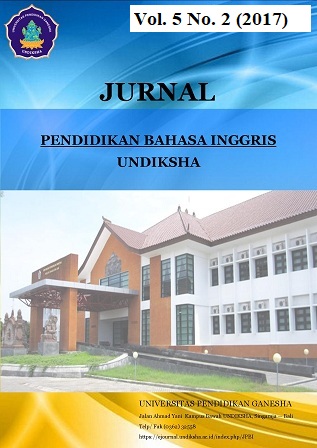AN ANALYSIS OF QUESTION POSED BY ENGLISH TEACHER DURING TEACHING AND LEARNING PROCESS AT SMP NEGERI 6 SINGARAJA
DOI:
https://doi.org/10.23887/jpbi.v5i2.18794Abstract
Penelitian ini bertujuan untuk (1) mendeskripsikan bagaimana guru bahasa inggris memberikan pertanyaan kepada siswa, (2) medeskripsikan bagaimana respon siswa terhadap pertanyaan guru. Penelitian ini merupakan penelitian studi kasus dengan subjek penelitian seorang guru bahasa inggris dan siswa kelas tujuh di SMP Negeri 6 Singaraja. Data dari penelitian ini dikumpulkan melalui observasi dan dokumentasi, maupun wawancara. Adapun instrument yang digunakan yaitu lembar observasi dan rekaman video, checklist, dan panduan wawancara. Data yang terkumpul dianalisis secara kuantitaf dan kualitatif. Hasil penelitian menunjukan bahwa (1) guru sebagian besar mengajukan pertanyaann convergent (61.07%) yang digunakan untuk mengecek pemahaman siswa. (2) pertanyaan procedural (25.89%) yang digunakan untuk mengevaluasi persiapan siswa dan berhubungan dengan rutinitas kelas, dan pertanyaan divergent (13.04%) yang digunakan untuk memelihara wawasan dengan memaparkan hubungan baru. Kemudian, adapun enam strategi yang digunakan, yaitu no calling out, cold call, repeating, prompting, waiting, and probing. Strategi yang paling banyak digunakan oleh guru adalah no calling out dengan presentase (54.35%). Kemudian, siswa memberikan tiga jenis respon dalam bentuk verbal (81,42%), non-verbal (4,74%), dan no-response (13,84%).Kata Kunci : Pertanyaan guru, Respon siswa
This study aimed to (1) describe how the English teacher gives question to the students, (2) describe how the students give response to the teacher’s question. This study was a case study with the subject of an English teacher and seventh grade students at SMP Negeri 6 Singaraja. The data were collected through observation and documentation, as well as interview. The instrument used were observation sheet and video recorder, checklist, and interview guide. The collected data were analyzed quantitatively and qualitatively. The result showed that (1) the teacher mostly posed convergent question (61.07%) which were used to check students’ understanding, (2) procedural question (25.89%) which were used to evaluate student preparation and dealt with classroom routines, and (3) divergent question (13.04% ) which were used to nurture insight by exposing new relationship. Then, six strategies were used, namely no calling out, cold call, repeating, prompting, waiting, and probing. The most used strategy by the teacher was no calling out with percentage (54.35%). Then, the students provided three kinds of response in the form of verbal (81.42%), non-verbal (4.74%), and no-response (13.84%).
keyword : Students’ responses, Teacher’s question
Published
2019-07-22
Issue
Section
Articles
License
Authors who publish with the Jurnal Pendidikan Bahasa Inggris Undiksha agree to the following terms:- Authors retain copyright and grant the journal the right of first publication with the work simultaneously licensed under a Creative Commons Attribution License (CC BY-SA 4.0) that allows others to share the work with an acknowledgment of the work's authorship and initial publication in this journal
- Authors are able to enter into separate, additional contractual arrangements for the non-exclusive distribution of the journal's published version of the work (e.g., post it to an institutional repository or publish it in a book), with an acknowledgment of its initial publication in this journal.
- Authors are permitted and encouraged to post their work online (e.g., in institutional repositories or on their website) prior to and during the submission process, as it can lead to productive exchanges, as well as earlier and greater citation of published work. (See The Effect of Open Access)













